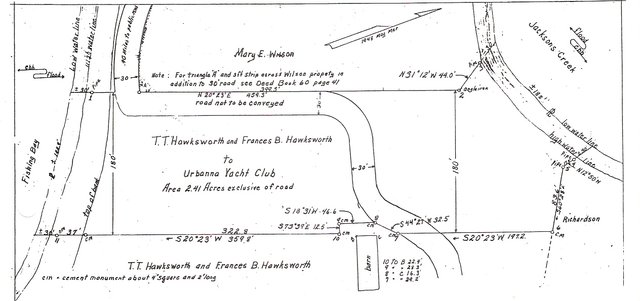FBYC History....
Jere Dennison
One of the items donated to our library this year is a painfully documented 1984 tome titled Stove Point by William A. Johns, M.D. and Theodore M. Curtis. This booklet commissioned by the Stove Point Improvement Association is a composed of 46 pages of narrative, plats, maps, photographs, property transfers, and lists of property owners. Johns and Curtis were property owners who did the extensive research on the history of the Point. It is not my intention to reprint this entire scholarly work in its entirety but only to highlight below several sections that may be of interest to our club membership. However, I need to apologize in advance to the authors for condensing, abridging, abbreviating, and, in some instances, rearranging the narrative to conform to the space requirements of the Log. The booklet will be available in the library for those that want to tackle the complete document.
Stove Point
(Store Point 1653-1766)
The first reference to Store Point found in land patent records was the land grant to Thomas Bourn from King Charles II on February 26, 1653 of 220 acres lying in Lancaster County (which then included Middlesex) upon the north side of the Piankatank River; beginning at the southwest side with the western branch of the Piankatank opposite to Store Point.
The prominent neck of land marking the entrance to the Piankatank was given the name of Store Point between 1648 and 1653. Legend has it that there was in fact a store at the southern end of Stove Point, a legend given credibility by the existence of the prominent sand spit then in this location which provided one of the few places on the eastern seaboard where a large ship could anchor within a few feet of shore and still be in twenty six feet of water. A large pit, believed to have been an ice house, was a prominent feature of the high land at the end of the point until it was filled in sometime in the 1960s. Such a store had be provisioned by water and large vessels would have been required to off-load cargo to other boats as there was no road to the end of Stove Point until the early 1950s.
A more plausible reason for the pit at the end of the point may be that this was the site of a whiskey still which a farmer named Joe Ward is known to have operated at this location.
A search of the records did establish and document ownership of Store Point/Stove Point from 1761 to the present time. On December 1, 1761 the Honorable Philip Grymes, Esq. sold to John Berry that tract and parcel of land commonly known by the name and appellation of Store Point lying and being in the County of Middlesex John Berrys will dated December 9, 1766 stated: I give my son John Berry II all that parcel of land I bought of Philip Grymes, Esq. commonly known by the name of Store Point. These were the last references to Store Point found in any written record. By the hand of a careless scribe Store Point became Stove Point.
For more than thee hundred years of the recorded history of the coastal areas of Virginia, Stove Point remained little changed except for the relentless erosion caused by the wind and tide. A search of court records tracing ownership of Stove Point for more than two hundred years reveals that until 1866 Stove Point was always sold or willed as one parcel totaling about one hundred twenty acres. In 1866 William Coulbourne, then owner, divided Stove Point into two parcels, one of twenty five acres, the other ninety four acres, and sold them separately.
In March 1935, T. T. Hawksworth bought these two parcels, paying $2,350 for the twenty five acre tract and $9,700 for the 94.5 acre tract, or about $100 per acre. On December 31, 1948 an event occurred which was to have a profound effect on the development of Stove Point. On that date the Hawksworths sold 2.41 acres of land as shown on the plat below to the Urbanna Yacht Club for $2,500. The club promptly changed its name to Fishing Bay Yacht Club.

Fishing Bay became the mecca for dedicated sailors of all ages, mainly from Richmond, who were quick to note the suitability of the Point as a site for a summer home. Alan McCullough who, as Vice Commodore, had acted on behalf of the Urbanna Yacht Club to buy the yacht club property at Fishing Bay, was the first of this new wave of summer visitors to purchase a lot on Stove Point on April 7, 1949.